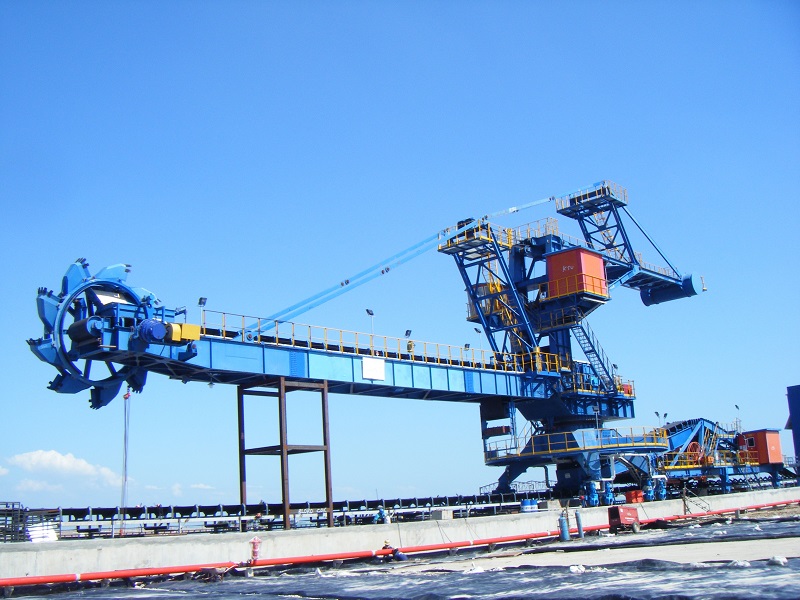Introduction and function of stacker reclaimer
stacker reclaimer
A stacker reclaimer is an efficient mechanical device for handling bulk materials. It can complete the task of handling a large amount of materials in a short time, and can move and rotate freely. It is suitable for various places such as warehouses, housing construction sites, docks and mines.

Generally speaking, the stacker-reclaimer is composed of four legs and a rotating platform. Through the linkage of these components, the stacking and placing of materials at different heights and directions can be completed. When handling materials, the robot first approaches the material pile, then tilts the grasping seedlings to the top of the pile, then uses its own telescopic device to lift and lift the grasping seedlings and hoist the materials, and then moves the materials to the target position.
The biggest advantage of the stacker-reclaimer is that the handling speed and efficiency are very high, and it can realize automation and unattended operation through programmable control and remote control. In addition, the operation of the robot is also very flexible, and it can complete tasks quickly and easily even in complex environments.
However, the stacker-reclaimer also requires a certain amount of maintenance and maintenance. When the machine is running, it is necessary to pay attention to whether there are abnormal sounds or odors in the key parts of the machine. At the same time, the color, looseness, wear and tear of the equipment should be checked regularly. If any problem is found, it needs to be adjusted and repaired in time. Only in this way can we ensure the normal operation of the machine, reduce the failure rate and improve work efficiency.
In short, the stacker-reclaimer is one of the indispensable mechanical equipment in the fields of modern logistics, transportation, construction, etc. Using it can greatly save manpower and time costs and improve production efficiency. At the same time, it is necessary to pay attention to the daily maintenance and maintenance of the machine to ensure that it can always be in good operating condition and contribute to the development of the enterprise and the improvement of working conditions.
 O'zbek
O'zbek slovenský
slovenský Azərbaycan
Azərbaycan Қазақ
Қазақ Latine
Latine ລາວ
ລາວ български
български नेपाली
नेपाली فارسی
فارسی Javanese
Javanese Українська
Українська Lietuvos
Lietuvos Română
Română Slovenski
Slovenski پښتو
پښتو Punjabi
Punjabi Bosanski
Bosanski Malti
Malti Galego
Galego Afrikaans
Afrikaans Esperanto
Esperanto 简体中文
简体中文 Српски
Српски मराठी
मराठी Ελληνικά
Ελληνικά čeština
čeština Polski
Polski ไทย
ไทย Nederlands
Nederlands Italiano
Italiano Tiếng Việt
Tiếng Việt Deutsch
Deutsch français
français русский
русский Português
Português Español
Español 한국어
한국어 Svenska
Svenska Malay
Malay اردو
اردو norsk
norsk Indonesia
Indonesia عربى
عربى Gaeilge
Gaeilge Türk
Türk Pilipino
Pilipino हिन्दी
हिन्दी Dansk
Dansk বাংলা
বাংলা English
English


What is a Metering Conveyor
In modern material handling systems, efficiency and precision are critical to maintaining smooth operations. Among the many specialized conveyors used in industries such as packaging, food processing, mining, and logistics, the metering conveyor plays a vital role. But what exactly is a metering conveyor, and why is it becoming increasingly important in production environments?
Read MoreJuli Engineering Gains Global Recognition Among Mining Conveyor Manufacturers
The mining industry relies heavily on efficient material handling systems to ensure productivity and safety in large-scale operations. Among the many solutions available, mining conveyors stand out as indispensable equipment for transporting bulk materials such as ore, coal, and aggregates. As demand for advanced solutions grows, Juli Engineering has established itself as one of the most reliable mining conveyor manufacturers, offering durable, high-performance systems tailored to global mining needs.
Read MoreDesign and Application of a Comprehensive Coal Spillage Handling System for Downwards Transportation Belt Conveyor
A belt conveyor with an annual production capacity of 3 million tons is installed in a main inclined roadway with a steep angle of 22°. During operation, issues such as coal overflow, spillage, and falling coal occur, particularly when transporting raw coal with high moisture content.
Read More